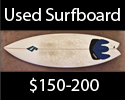Beginner Tips
How to Turtle Roll
Are you learning to surf, and wondering how on Earth to get your longboard past the breaking waves? Read on to learn how to turtle roll, a very necessary surfing maneuver that will make your paddle out much easier.
You may have seen shortboarders push their boards under oncoming waves. This maneuver is called a duck dive. Unfortunately for us, a duck dive can’t be performed on longboards. Why is this? Well, a duck dive involves submerging the surfboard under the oncoming wave. Since longboards have such a huge volume, and therefore very buoyant, they can’t be pushed under the wave. Shortboards are easier to get under the oncoming waves, but never fear, longboards have the advantage of faster paddling. As longboarders, we’re going to learn the turtle roll.
The turtle roll is a necessary longboard surfing skill that will help you make it out to the line up. Yes, surfing is all about riding waves, but before we can think about riding waves, we need to cover some basics of surfing and paddling out. To preface our talk about how to turtle roll, make sure you are practicing all the other parts of a smart paddle out with a longboard. That means you’re looking for channels, you’re timing the sets, and you’re paddling efficiently. Click if you need some help on paddling out.
Now you’ve got a good understanding of paddling out, let’s talk about how to turtle roll.
1. Paddle towards the wave straight on. If you’re at an angle, it’s likely you will get hurled from your board.
2. As the wave approaches, grab the rails (side of the surfboard) slightly above your shoulders. You will want the nose pointing down slightly.
3. Hold on tight, as you do not want to lose your grip on the board. It’s okay to wax the rails to help maintain your grip.
4. As soon as the wave begins to get close to you, breathe deep, and roll the board upside down, fin side up. As the wave is approaching, push up from the board, and give yourself a powerful lean to one side. Raising your torso up slightly will give you momentum and leverage to turn the board over.
5. For powerful surf, hold the board close. The less water you allow between you and the board equates to an easier hold.
6. When underwater, stay loose and relaxed. Don’t get stiff or try to out-muscle the wave. Also, don’t wrap your legs around the board, just hang on to the rails with your hands.
7. Turtling rolling can result in a loss of ground, so as the wave is passing over your upside down board, give yourself a frog kick underwater and push yourself forward. Worry about this after successfully turtle rolling without the frog kick.
8. Once the wave has passed, flip the board over. To get back on the board, kick with your legs, push with one arm and pull with the other.
9. Now that you are laying back on your board, paddle hard to make it to the line up. This is where you really want to make a push to get out of the wave’s impact zone.
As with most things when we’re learning to surf, try practicing this move in small whitewater to get comfortable with the feeling of turtle rolling your board over.
Good luck with the paddle out! Give us a shout if you’ve got questions on our Ask a Surf Scientist Page!















0 Comments